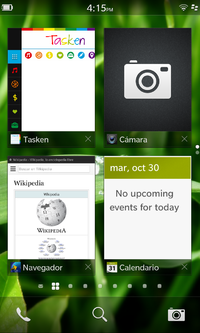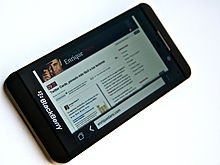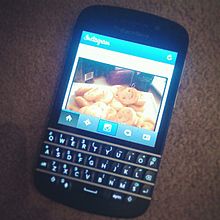
BlackBerry 10
About this schools Wikipedia selection
SOS Children made this Wikipedia selection alongside other schools resources. Before you decide about sponsoring a child, why not learn about different sponsorship charities first?
 |
|
| Company / developer | BlackBerry Limited |
|---|---|
| OS family | QNX ( Unix-like) |
| Working state | Current |
| Source model | Closed source |
| Initial release | January 30, 2013 |
| Latest stable release | 10.0.10.116 |
| Available language(s) | Multilingual |
| Available programming languages(s) |
C/ C++: Native SDK, C++/ Qt: Cascades SDK, HTML5/ Javascript/ CSS: Webworks SDK, ActionScript: Adobe AIR, Java: Android runtime |
| Supported platforms | BlackBerry line of smartphones |
| Kernel type | Real-time microkernel ( QNX) |
| Default user interface | Graphical |
| License | Proprietary |
| Official website | www.blackberry.com/BlackBerry-10/ |
BlackBerry 10 is a proprietary mobile operating system developed by BlackBerry Limited (formerly Research In Motion) for its BlackBerry line of smartphone and tablet handheld devices. The most recent example being the Z10 smartphone. It is based on QNX which was acquired by BlackBerry in April 2010. BlackBerry 10 is the third major release of a QNX based operating system, following the release of BlackBerry Tablet OS with the BlackBerry PlayBook on April 19, 2011, and BlackBerry Tablet OS version 2.0 on February 21, 2012. BlackBerry 10 and BlackBerry Tablet OS have numerous technical similarities, with BlackBerry 10 providing substantial enhancements over the earlier releases.
Launch announcement
On November 12, 2012, Heins announced a January 30, 2013 launch of the BlackBerry 10 operating system and the first smartphones running it. The operating system, as well as two devices, the Z10 (a full touchscreen device), and the Q10 (a device equipped with a physical keyboard), were announced simultaneously around the world on January 30, 2013. The company also announced that the BlackBerry PlayBook tablet would receive an update to BlackBerry 10 later in 2013.
User interface
On 1 May 2012, Thorsten Heins, CEO of BlackBerry officially unveiled the BlackBerry 10 platform. The features shown off at the BlackBerry World conference included a unique platform-wide flow interface, a new intelligent keyboard, as well as a camera app which allows the user to adjust the photo or individual faces by moving through time scale to optimize picture quality. The user interface also includes the ability to run 8 "Active Frames". Active Frames are applications that are currently running within the operating system, but minimized. Some are capable of showing a feed of live information on the home screen. The Operating System also features the 'Hub', a list accessible from anywhere in the OS where all notifications including emails, social networking sites and text messages in one complete list. It eliminates the home button that are found in iOS and Android systems.
Features
Gestures
Gestures are largely integrated within the BlackBerry 10, featuring four main gestures for easy navigation. Quick swiping up from the bottom edge of the bezel will result in users returning to the home screen. From there, users can view and close active applications. Users can also swipe from the top edge, to bring down a quick setting shade on the home screen, or an option shade on other supported apps. Also, while using any application, the upside down J-hook (starting from the bottom of the bezel and moving upward and right) allows users to peek at any notifications or messages on the BlackBerry Hub. Finally, swiping left to right (or vice versa) scroll through the available screens.
Multitasking
Similar to BlackBerry Tablet OS, BlackBerry 10 OS also supports multitasking with gesture integration. Swiping up from any application brings up the running application screen, which function as an application switcher and a task manager. Users can switch through running applications by tapping on any of the apps or close them by tapping on the ‘X’ on the lower right of the app itself. Some apps also offer widget like functionality, similar to Android. Examples of this include, picture app cycling through a photo album or calendar app showing upcoming events and meetings. Most accessed apps are also view-able to users on this multitasking screen.
BlackBerry Hub
BlackBerry Hub acts as a notification centre, with the user’s entire social and email accounts integrated into one app. These include, at launch, standard E-mail client, Twitter, Facebook, BlackBerry Messenger (BBM), and LinkedIn (with options to turn any of these services off). Standard notifications like missed calls, voicemail, and system updates also appear on the hub. The hub can be accessible from any app/lock screen, by performing an upside down j-hook gesture. Users can perform various tasks like compose emails, send emails, and browse social networks, without accessing other apps. Developers are also given options to integrate apps into the Blackberry Hub.
BlackBerry Balance
BlackBerry Balance is a new feature introduced in BlackBerry 10, enabling users to keep both personal data and office work data separated in its own spaces. Using Blackberry Enterprise Server 10, IT departments can allow users to set up work-spaces that automatically install applications and email accounts. After completion, users can navigate between personal and work profiles, by swiping down on the apps page. All of the user’s data is secured via 256-bit AES encryption, and any files created will stay within the profile partition.
Time shift camera
BlackBerry 10 features camera software that takes multiple frames of every photo. This feature allows users to adjust a photo easily to correct issues such as closed eyes.
BlackBerry's popular messaging application now includes the ability to video chat as well as the ability to share the contents of a user's BlackBerry screen with others.
Android player
BlackBerry 10 introduced an Android runtime layer, which allows users to sideload applications designed to work on the Gingerbread (Android 2.3) and below operating system. Gingerbread, however, is showing signs of age with waning usage. Less than 46% of Android devices connected to the Play store are running 2.3 or below. Because of this, Blackberry officially announced that it will soon update the runtime layer to include compatibility with Jelly Bean (Android 4.1) applications. This will broaden the availability of big-name applications on the BB10 platform substantially.
Keyboard
BlackBerry 10 features a new virtual keyboard layout that mimics BlackBerry’s past generation’s physical keyboards. The letters and numbers feature fonts and frets similar to previous BlackBerry devices. The keyboard also learns the user’s typing preferences, trying to auto-predict the next word. The keyboard also uses contextual information to predict the next letter in a word sequence. In this case, words will appear above the letter that the OS thinks that the user will touch next. Users can then perform a flicking upwards gesture above the letter to quickly select that word. Also, swiping from right to left in keyboard deletes the entire word rather than using backspace to delete each character.
Voice control
Voice Control was also introduced in BB10, allowing users to send BBMs, schedule meetings, update social networks, and open apps using natural speech patterns. Voice control can also be used for typing on any screen that accepts keyboard input.
BlackBerry Link
BlackBerry Link allows users to sync and organize music, documents, photos, and videos between a BB10 device and a computer. It is compatible with Mac and PC, and supports iTunes and Windows Media Player. Syncs are done over Wi-Fi or USB. Blackberry Link also facilitates device switches from Android and iOS as well as BB10 software updates. Link transfers contacts, files, calendars, tasks, bookmarks, alarm clocks, SMS, phone logs, WLAN profiles and other information between devices.
Applications
Bundled applications
BlackBerry 10 features a number of included applications that help users perform various tasks and activities. These include maps, Web browser, Remember (Sticky notes app), Docs to Go, Story Maker (video and music stitching app), calculator, clock, music, media, weather, and file manager. Cloud service integrations like Box and Dropbox are also integrated by default. In addition, BlackBerry's popular messaging service, BlackBerry Messenger is included with BlackBerry 10.
Third-party applications
At the time of the release in January 2013, BlackBerry 10 operating system had 70,000 third party applications. This represents a substantial increase over the BlackBerry PlayBook which launched with only 3,000 third party applications. In end of March 2013, BlackBerry 10 has 100,000 apps, but still less of imaging favorites like Instagram and Snapseed. At BlackBerry Live 2013, BlackBerry announced that they had surpassed 120,000 apps, and that Skype would become available on the BlackBerry Z10.
Distribution
Unlike the previous BlackBerry OS (but similar to the BlackBerry PlayBook), applications must be downloaded through BlackBerry's BlackBerry World storefront, which comes included with BlackBerry 10.
Devices
| Device Name | Description |
|---|---|
| Z10 | A smartphone with no physical keyboard (fully touchscreen). |
| Q10 | Smartphone with classic BlackBerry QWERTY keyboard. |
| Q5 | Smartphone with classic Curve like BlackBerry QWERTY keyboard (targeted to emerging markets). |
Developer activities
Engagement strategy
Building up to the launch, the company made substantial changes to how it had previously engaged developers, being substantially more aggressive at courting developers, solving issues and being transparent about development updates. The company sent two teams to engage developers. The first, focused on acquiring premier applications from third parties. The second team focused on engaging the broader development community and building the platforms application count.
Prototype smartphones
In May 2012, the company released a prototype touch screen smartphone to BlackBerry developers as part of the BlackBerry 10 Jam Conference in Orlando, Florida. The Dev Alpha A' device, which resembled a small BlackBerry PlayBook, ran an early version of the operating system and was provided as a means for developers to develop and test their applications on a physical device.
In September 2012, a second developer prototype was released in September 2012, known as the Dev Alpha B. It includes a faster processor and a number of internal improvements.
A third developer device, the Dev Alpha C, was announced on November 29, 2012, and is the first developer prototype to demonstrate the physical keyboard capabilities of BlackBerry 10. Acquisition of a Dev Alpha C device is based around a point system, meaning that developers who have previously developed apps for RIM, or have had the Dev Alpha A/B devices, will have a higher chance of receiving a device than a new BlackBerry developer. It was released at the BlackBerry Jam Europe 2013 event in February 2013.
Portathons
Pre-launch “Portathons” held by Blackberry have received up to 19,000 applications submitted per weekend.
Reviews
Reviews of BlackBerry 10 have been mixed to good. David Pogue of the New York Times noted that the software was, “simple to master, elegantly designed and surprisingly complete. It offers features nobody else offers, some tailored to the corporate world that raised BlackBerry aloft in its glory days.” Walt Mossberg of the Wall Street Journal referred to the operating system as “logical and generally easy to use”. Mossberg praised the virtual keyboard, camera software, and messaging hub; but criticized its application ecosystem, cloud capabilities and the immaturity of some features. Gizmodo's Kyle Wagner states that BlackBerry 10's home screen "gives BB10 the single best implementation of multitasking of any mobile OS right now". Wagner goes on to say that the Hub "works out to function a bit more like a junk drawer". He also reports what he refers to as the "Tragic Flaw": "Unlike every other major OS right now, BlackBerry does not feel fully integrated."
In comparison to that, CrackBerry.com views the new features more positively and takes into account the fact that the OS is brand new. It says that the BlackBerry Hub “is a polished solution to efficiently managing the influx of messages we have coming at us...". It goes on to mention minor discrepancies and finally pointing out that many of the problems are getting fixed in future updates (some now released, e.g. battery life improvements, call ringtone disabled in bedside mode). It criticises the limited customisability options compared to BlackBerry OS (Alert tone volumes, alert light colour). Regarding the apps in BlackBerry World "really impressed by the quality of apps BlackBerry World has to offer", it notes that the application ecosystem is not as large as Android and iOS because of its age (brand new) and finishes with "doubtlessly many more will come around once they see the Z10 getting traction in the wild." Its general summary of BlackBerry 10 (with thought for its predecessor) "is that BlackBerry 10 really is the best of the old and the best of the new assembled seamlessly into an elegant, practical, and integrated package."
Version history
BlackBerry 10.0
| Obsolete | Current | Future Release |
| Version | Release Date | Improvements/New features |
|---|---|---|
| 10.0.9.348 | (BlackBerry 10 release version) | See BlackBerry 10 for features. |
| 10.0.10.85 | March 1, 2013 |
|
BlackBerry 10.1
| Obsolete | Current | Future Release |
| Version | Release Date | Improvements/New features |
|---|---|---|
| 10.1.0.273 | May 14, 2013 |
|
Branding controversy
The platform was originally called BBX but this was changed when BlackBerry was blocked from using the BBX trademark after legal action from BASIS International, who already uses it for their software.
Licensing
BlackBerry CEO, Thorsten Heins, before the BlackBerry 10 launch, has said that the company is considering licensing BlackBerry 10 to other OEMs.




